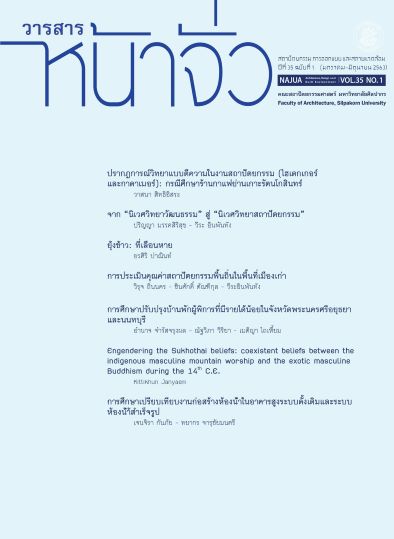Hermeneutic Phenomenology (Heidegger and Gadamer) in Architecture: Coffee Shop Case Studies in Rattanakosin (Bangkok Old Town)
Keywords:
Hermeneutic, Phenomenology, Martin Heidegger, Coffee shop, Unit of Analysis, AtmosphereAbstract
Hermeneutic Phenomenology by Heidegger and Gadamer has been studied in many architectural academics, but the methodology of understanding a phenomenon is still unclear. The researcher conducted the experiment to construct a tool summarized in a process of phenomena including interpretations for the benefit of being used in any further research.
The development of this tool is based on research “From Epistemology to Methodology: A Study of Phenomenology in Architecture” by San Suvajaraphinan, especially the process of searching for “unit of analysis”. The analysis, conclusion and interpretation survey in coffee shops as case studies to examine the tool. Coffee shops have been examined since combining cultural phenomena and value in the atmosphere which is an important architectural element.
Results are from the research methodology allowing the phenomena to show off. The “unit of analysis” which is the consequence is “the corresponding of human space”. The results of phenomenon analysis shows “comfortable space, social talk” in case study# 1 at the old coffee shop in the area, “uncomfortable space but beautiful images” in case study# 2 and 4 that are popular cafes in online communities, “comfortable area, sensual atmosphere” in case study# 3 which is a coffee shop that promotes social activity as well as an art gallery area on the second floor area, “uncomfortable space on the first floor, but comfortable space on the second floor” in case study# 5, “comfortable area with a variety of seating height” in case study# 6 which is a leading brand coffee shop making various forms of seating and table arrangement The final result is “sensory connection area” in case study# 7, which is a coffee shop that uses the strength of being located in the flower wholesale market to decorate space including the transitional walkway as a link to create memory space for the fragrance of flowers. The discussion of phenomenon depends on time, person, place, and culture, helping to understand dimensions in an architectural space deeper than just a visual image.
References
- Altman, Irwin. and Low, Setha. M. (1992). Place attachment. New York, Plenum Press.
- Boyle, Sheryl. (2011). Sensory Readings in Architecture. Retrieved on July 2018, From http://centreforsensorystudies.org/wp-content/uploads/2011/09/Sensory-Readings-in-Architecture.pdf.
- Chintamayakool, Worawee. (2006). kānraprū sǣng khō̜ng saphāpwǣtlō̜m phāinai thī mī phon tō̜ rūpbǣp prayōt chaisō̜i læ khunkhā ʻākhān kō̜ranī sưksā : rān kāfǣ nai hāng sapphasinkhā. (in Thai) Lighting perception of interior environment that affects to form, function and building’s values a case study coffee shop in department store. Master of Architecture (Interior Architecture), Bangkok University.
- Devakula, Piyalada. (1999). A tradition rediscovered: Toward an understanding of experiential characteristics and meanings of the traditional Thai house. Doctoral Dissertation, University of Michigan.
- Holl, Steven. (1996). Intertwining. Princeton Architectural Press.
- Holl, Steven, Juhani Pallasmaa, and Alberto Pérez Gómez. (2006). Questions of perception: phenomenology of architecture. San Francisco, CA: William Stout.
- Inpuntung, Vira and Srisaowanunt, Adisorn. (2016). nǣo khwāmkhit rư̄ang sathānthī læ prākottakān witthayā kap kānsưksā ngān sathāpattayakam phư̄n thin . (in Thai) (The Concept of Place and Phenomenology in Study of Vernacular Architecture). Built Environment Inquiry Journal Faculty of Architecture Khon Kaen University. 15(1), 1-20.
- Issaratumnoon, Wimonrart. (2008). kānsưksā phư̄a čhattham khrōngkān ʻanurak læ fư̄nfū yān sāmphrǣng. (in Thai) A study for the preservation and renewal program of Sam Prang District. Master of Architecture, Chulalongkorn University.
- Oldenburg, Ray. (1999). The great good place. New York: Mar- lowe & Company.
- Panin, Tonkao. (2010). Kon lae Kwam kid tang satapattayakam (in Thai). Bangkok: Sommut.
- Plodpluang, Unya. (2013). kān wikhro̜ khō̜mūn chœ̄ng prākottakān witthayā. (in Thai) (Data Analysis in Phenomenology Studies). Nursing Journal of The Ministry of Public Health, 23(2), 1-10.
- Shirane, Haruo. (Ed.). (2002). Early Modern Japanese Literature: An Anthology, 1600-1900. Columbia University Press.
- Suwatcharapinun, Sant. (2011). čhāk yānnawitthayā sū krabūan withī wičhai : sưksā prākottakān witthayā nai sathāpattayakam. (in Thai) (From Epistemology to Methodology: A Study of Phenimenology in Architecture). Research sponsored by The Thailand Research Fund.
- Tanizaki, Junichiro. (2001). In praise of shadows. Random House.
- Teeraparbwong, Komson. (2016). (in Thai) “Atmosphere: Architectural Environments-Surrounding Objects” By Peter Zumthor. Journal of Environmental Design, 3(2), 168-178.
- Waxman, Lisa. (2006). The coffee shop: Social and physical factors influencing place attachment. Journal of Interior Design, 31(3), 35-53.
- Zumthor, Peter. (2006). Atmospheres: Architectural environments, surrounding objects. Basel : Birkhäuser.




